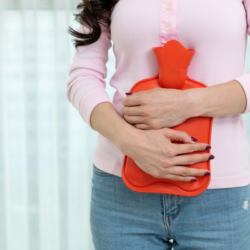Secondary amenorrhoea is a medical term that describes the absence of menstruation for three or more consecutive months in a woman who previously had a regular menstrual cycle. As you can imagine, this problem is much more common than you might think. So how do you explain this sudden cessation of your periods?
What is secondary amenorrhoea?
Secondary amenorrhoea can be a sign of a wide range of medical conditions, lifestyle changes or mental health problems. It can be caused by reproductive problems such as polycystic ovary syndrome (PCOS) or eating disorders such as anorexia or bulimia.
Have you recently lost or gained significant weight? Have you started to exercise more than usual? These factors can all influence your menstrual cycle.
What impact do hormones have on the menstrual cycle?
Hormones play a key role in regulating your menstrual cycle. Problems such as hyperthyroidism or hypothyroidism, or disorders of the pituitary gland, can all lead to secondary amenorrhoea.
And don’t forget, pregnancy is the most common cause of secondary amenorrhoea in women of childbearing age. That’s why it’s always a good idea to take a pregnancy test if you’ve had unprotected sex and your periods have stopped.
What causes secondary amenorrhoea?
Secondary amenorrhoea can be caused by a wide range of factors. These factors are generally linked to hormonal changes in your body. Here are some of the most common factors.
Polycystic ovary syndrome
Polycystic ovary syndrome (PCOS) is a medical condition in which a woman has a hormonal imbalance. This can lead to cysts in the ovaries, weight gain and possibly secondary amenorrhoea.
Can weight loss lead to secondary amenorrhoea?
The impact of weight changes on the menstrual cycle should not be underestimated. The relationship between body weight and the menstrual cycle is complex and can be influenced by a variety of factors.
Impact of weight loss
Significant weight loss, especially rapid and uncontrolled weight loss, can lead to hormonal changes in the body that can interrupt the menstrual cycle. This is often the case with women suffering from eating disorders such as anorexia. The body perceives rapid weight loss as stress and may suspend non-essential functions, such as reproduction, to save energy.
Impact of weight gain
Conversely, weight gain, particularly obesity, can also affect the menstrual cycle. Excess body fat can have an impact on hormones, particularly oestrogen. Overproduction of oestrogen can inhibit ovulation, which can lead to amenorrhoea.
Can excessive stress prevent periods from coming?
Stress is another factor that can have profound effects on the menstrual cycle. Stress hormones, such as cortisol, are designed to prepare the body to respond to emergency situations. However, when stress becomes chronic, it can upset the body’s hormonal balance and affect the menstrual cycle.
The role of cortisol
Cortisol is a hormone produced by the adrenal glands in response to stress. It helps regulate a variety of bodily functions, including immune function, blood sugar and metabolism. However, when produced in excess, cortisol can have an inhibitory effect on ovulation.
Stress management
Stress management is therefore an essential part of maintaining a healthy menstrual cycle. Stress management techniques such as meditation, regular exercise, a balanced diet and sufficient sleep can help to reduce cortisol levels and restore hormonal balance.
How do I know if I’m suffering from secondary amenorrhoea?
If you think you may be suffering from secondary amenorrhoea, your doctor may ask you a number of questions about your medical history and lifestyle. He or she may also ask you to undergo tests to determine the cause of your missed periods.
Physical examination
Your doctor may do a physical examination to check for any signs of pregnancy or underlying health problems.
Laboratory tests
Blood tests can help determine whether you have hormonal imbalances or other medical problems that could be causing amenorrhoea.
What is the treatment for secondary amenorrhoea?
Treatment for secondary amenorrhoea will depend on the underlying cause. In some cases, you may need medical treatment. In others, lifestyle changes may suffice.
What medicines are available for secondary amenorrhoea?
Drug treatment can be an effective solution if your amenorrhoea is due to a hormonal imbalance. Your doctor may prescribe different types of medication depending on the specific cause of your amenorrhoea.
Contraceptive pills
In some cases, contraceptive pills may be prescribed to help regulate the menstrual cycle. These medicines contain hormones that can regulate ovulation and restore a regular menstrual cycle.
Medication for hyperprolactinaemia
If your amenorrhoea is due to an excess of prolactin, a hormone that can inhibit ovulation, your doctor may prescribe medication to reduce the level of this hormone in your body.
Lifestyle changes and secondary amenorrhoea
If your amenorrhoea is due to lifestyle factors, such as stress or weight changes, it may be necessary to make changes to your daily life. These changes may involve altering your diet, increasing your physical activity or finding effective ways to manage stress.
Balanced diet
A balanced diet is essential for maintaining a regular menstrual cycle. Try to include a variety of healthy foods in your diet, including fruit, vegetables, whole grains, lean proteins and healthy fats.
Regular exercise
Regular exercise can help regulate your menstrual cycle by improving your overall health and helping to regulate your hormones. However, it’s important not to overdo it, as excessive exercise can also disrupt your menstrual cycle.
Stress management
Stress management can also play a crucial role in regulating your menstrual cycle. Try incorporating relaxation techniques, such as meditation or yoga, into your daily routine to help reduce stress levels.
What is the ‘All in’ method for missed periods?
The ‘All in’ method is an approach to weight regain aimed primarily at people suffering from amenorrhoea due to eating disorders or undernourishment. This strategy involves eating without calorie restriction or excessive control of food intake. The aim is to enable the body to return to its ideal weight, a natural, healthy weight at which it functions optimally.
Increasing calorie intake and reducing physical activity are key components of this method. Providing the body with sufficient energy and nutrients encourages the normalisation of hormone levels, which can lead to the resumption of menstrual cycles.
It is essential to note that the implementation of the “All in” method must be accompanied by healthcare professionals, such as nutritionists and psychologists, to ensure that weight regain is achieved in a balanced and healthy way, while supporting the patient’s mental health.
Regular monitoring and a personalised eating plan are crucial to the success of this method, adapting to individual dietary and emotional needs. It is also important to create a supportive environment, where weight and healthy eating issues are addressed in a positive and non-judgemental way.
Psychological impact of the absence of rules
The psychological impact of secondary amenorrhoea can be significant. Affected women may experience anxiety, reduced self-esteem and sometimes depressive symptoms, due to concerns about fertility and health. It is essential to address these issues by offering emotional support and encouraging open communication with healthcare professionals.
Strategies such as cognitive behavioural therapy, meditation and support from discussion groups can be beneficial. Awareness of the emotional effects and seeking professional help are crucial to managing these impacts. It is also important to stress the need to take care of one’s mental health, as well as one’s physical health, when treating secondary amenorrhoea.
What is the difference between secondary amenorrhoea and hypothalamic amenorrhoea?
Amenorrhoea, or the absence of menstruation, is a condition that can worry many women. Among its various forms, secondary amenorrhoea and hypothalamic amenorrhoea are two common but often confused types. In this article, we will explore the key differences between these two conditions.
Secondary amenorrhoea: An absence of periods after a normal cycle
Secondary amenorrhoea occurs in a woman who has already had a normal menstrual period, but then experiences an absence of periods for at least three months. This condition may be the result of various factors:
- Hormonal Imbalances: Problems with the thyroid gland or ovaries, such as polycystic ovary syndrome (PCOS), can lead to secondary amenorrhoea.
- Lifestyle factors: Intense stress, extreme weight loss and excessive exercise are common factors.
- Medical Conditions: Pituitary disorders or other medical conditions may also be involved.
Treatment of secondary amenorrhoea depends on the cause. It may include lifestyle changes, hormone treatments, or medical interventions for the underlying problems.
Hypothalamic amenorrhoea: When the brain interrupts the cycle
Hypothalamic amenorrhoea, on the other hand, is specifically linked to disturbances in the hypothalamus, a region of the brain that regulates the hormones needed for the menstrual cycle. Common causes include :
- Stress and Weight: Excessive weight loss, eating disorders (such as anorexia), or severe psychological stress can affect hypothalamic function.
- Intense Exercise: In some athletes, extreme physical training can disrupt the menstrual cycle.
Treatment for hypothalamic amenorrhoea is aimed at correcting the triggering factors, such as restoring a healthy body weight or managing stress. Hormonal supplements may also be used.
Secondary vs Hypothalamic Amenorrhoea
| Criteria | Secondary Amenorrhea | Hypothalamic Amenorrhea |
|---|---|---|
| Definition | Absence of menstruation after a normal cycle | Cessation of menstruation due to an imbalance in the hypothalamus |
| Main causes | Hormonal imbalances, lifestyle factors, medical problems | Excessive weight loss, stress, strenuous exercise |
| Symptoms | Absence of periods, symptoms linked to underlying causes | Absence of periods, often associated with symptoms of stress or weight loss |
| Treatment | Hormonal treatments, lifestyle changes, treatment of underlying conditions | Restoration of a healthy weight, stress management, sometimes hormone supplements |
In conclusion, although secondary amenorrhoea and hypothalamic amenorrhoea share the common symptom of the absence of menstruation, their causes and treatments vary considerably. It is essential to consult a doctor for an accurate diagnosis and a suitable treatment plan.
References and recommended books
- https://pubmed.ncbi.nlm.nih.gov/28368518/
- “I don’t have my period any more”.
- “No period, now what ?”
- https://pubmed.ncbi.nlm.nih.gov/37661145/





